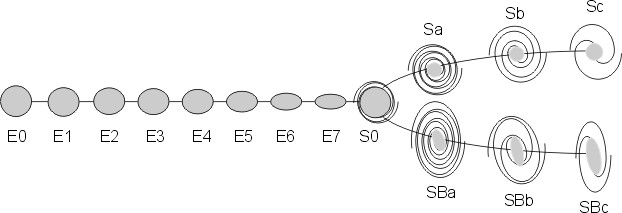
Image description: Composite image of galaxies photographed with the Hubble Space Telescope and the Sloan Digital Sky Survey. They are arranged in the order of the Hubble sequence classification (E: elliptical galaxies; S0: lenticular galaxies; Sa_b_c_d: spiral galaxies and Pec: irregular galaxies). Credits: HST. SDSS. GEPI.

Image description: Spiral galaxies are further subdivided based on the structure of their arms. Sa type galaxies have poorly defined spiral arms and a more massive central bulge, while Sc type galaxies have more distinct arms and a smaller bulge. Elliptical galaxies are classified from "E0" to "E7", according to their degree of flattening. "E0" represents an almost perfect ellipse, while "E7" is highly flattened.
The Hubble sequence is a galaxy classification system proposed by astronomer Edwin Hubble in 1926. It organizes galaxies based on their shape and morphological characteristics. This classification has played a crucial role in understanding the evolution of galaxies and the universe.
The Hubble sequence divides galaxies into four main categories:
The Hubble sequence is sometimes interpreted as an evolutionary progression. For example, spiral galaxies can become elliptical after major mergers. However, this is not a strict rule, and galaxy formation depends on complex factors such as gravitational interactions, local environments, and gas reserves.
| Type | General Shape | Main Characteristics | Example |
|---|---|---|---|
| Elliptical E0-E7 | Spherical to ellipsoidal | Little gas and dust, population of old stars | M87 |
| Lenticular S0 | Disk with central bulge | Transition between elliptical and spiral, little star formation | NGC 2787 |
| Spiral Sa-Sc | Disk with spiral arms | Increasing star formation rate, more or less tight spiral arms | Andromeda (M31) |
| Barred spiral SBa-SBc | Disk with central bar and spiral arms | Star formation in arms and bar, more concentrated gas distribution | NGC 1300 |
| Irregular Irr | Asymmetric, undefined shape | Rich in gas and dust, intense star formation, often result of collisions or disturbances | NGC 1427A |
Source: NASA/IPAC Extragalactic Database and ESA/Hubble Space Telescope Science.